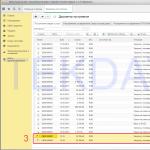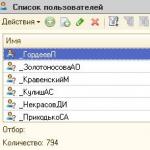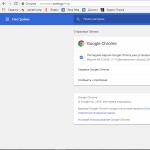The display of a homemade on-board computer is a transparent backlit image of a car, on which 9 holes are drilled, in which miniature red light bulbs (LEDs) are installed. The acoustic signaling device is located in any convenient place behind the display. If the car is on the handbrake and the ignition is turned on, the NC light comes on and a double warning signal sounds, repeating every few seconds while the ignition is on. Indicator of depressurization of the brake system. When this malfunction occurs, it lights up and an intermittent sound constantly sounds. beep. H1 lights up when the pressure in the lubrication system of a car engine drops with the ignition on. In this case, a fourfold acoustic signal is heard, repeating every 2 minutes.
In addition to the brake sensors "T.Ts." (central brake) and "R.T." (hand brake) an insufficient oil pressure sensor (terminal “M”) is also used without modification. Door sensors "D1-D4", hood "K" and trunk "B" are installed additionally. These are the same microswitches as standard interior lighting switches located in the door openings. When the door is closed and the switch button is pressed, there is no contact. When the door is opened, the button is released and shorts the conductor to ground. Such sensors are additionally installed in the openings of all four doors, as well as at the hood lock and on the opening of the trunk lid (fifth door).
The diagram of a homemade on-board computer, taken from the Radio Constructor 2002 magazine, is shown in the figure below.

Clock pulses with a frequency of 32 Hz are supplied to the input of the binary counter D2 from the multivibrator on elements D1.2 and D1.2. Resetting the counter is controlled by "NAND" D5.1. At the moment the power is turned on, the charging current C2 through R2 sets the counter to zero. The power is turned on simultaneously with the ignition being turned on. When the ignition is on, the counter constantly runs in a circle.

There are three RS flip-flops of the D3 chip. The first trigger is set to zero when the ignition is turned on. Its output will become zero, which will remain there until counter D2 counts from zero to three half-second pulses available at its output “8”. If one door or several doors, the hood, and the trunk are not closed before turning on the ignition, then a low logic level appears at the connection point of the diodes VD10-VD15 and R8. Both inputs of "2OR-NOT" D4.1 receive zeros, and the output of D4.1 will be one. This leads to the appearance of zero at the output "4OR-NOT" D6.1 and element D6.2 begins to pass pulses from output "8" D2 with a frequency of 2 Hz to the trigger input of the multivibrator D5.2-D5.3, which generates pulses with a frequency of 1 kHz, which, through VT1, are supplied to emitter B1.

Therefore, if the car was not completely closed before turning on the ignition, then, in addition to the light indication on the display, three warning tones are heard. The second trigger D3 works with the handbrake. If it is raised, the "RT" terminal shorts to ground. The charging current C4 sets counter D2 and trigger T2 to zero. A zero appears at the output of trigger T2, and just as in the case of an open door, the sound alarm turns on. After two sound pulses, a logical one appears at the output “32” of counter D2. And this returns the T2 trigger to the single state. The buzzer goes off. However, if the closed action of the handbrake sensor is not terminated, after four seconds a unit appears at output “128” D3, which, using the C9-R14 circuit, creates a positive pulse that resets trigger T2. And the double beep is repeated again. And so on, every four seconds, until the handbrake lever is released.

The device also works when the low oil pressure sensor is triggered. But here another TZ trigger is involved, the sound signal is four times, and repeats every 2 minutes. If the brake system leaks or brake fluid leaks, the cathode VD4 is shorted to ground. A one appears at output D1.4 and the intermittent sound signal sounds constantly.

The display screen is made of a sheet of plexiglass, which is uniformly painted in dark blue, and the image of the car is engraved on it, in the paint. If you illuminate the display with a green lamp (H10) from the inside, a green image of the car glows against a dark background. In the right places on the display, holes are drilled into which car baseless signal lamps H1-H9 (or LEDs), painted red, are tightly inserted. The tone of the acoustic signal is set by selecting resistor R4, and the sound duration is set by R1. This on-board computer has been working without interruption for several years.
Forum on homemade on-board computers
Discuss the article ON-BOARD COMPUTER WITH YOUR OWN HANDS
Many car enthusiasts want to know their fuel consumption, battery charge, temperature in the cabin and outside. The on-board computer can help with this. They are different, which is why we decided to tell you how to install an on-board computer with your own hands. In our case, this will be the most budget-friendly on-board computer. Photos from installation and video at the end of the article. The car is a Lada Kalina, and we have a sidecar built into the ashtray. Such an on-board vehicle can be made and installed on VAZ Kalina, Granta, 2110, 2114, 2115 and others.
The on-board computer displays the main parameters: temperature, speed, injection, consumption, etc.

There is a menu that displays errors. By the way, using this on-board computer you can erase errors.

The bortovik also shows acceleration to 100 km/h and just speed.

So we started the engine, the readings are all normal.

We connected this on-board computer to the OBD connector. Here come the wires.

How did we make an on-board computer? Here's the diagram.

For those who will try to make an on-board computer on their own, here is the diagram. And more detailed description The circuit itself can be found in the links in the description of the video below.

The cost of this on-board computer turned out to be about 150-200 rubles. Screen from mobile phone Siemens (lay in our closet), the microcontroller that is installed here costs 50 rubles, textolite costs 100 rubles. All other parts are used, they were in our boxes in the garage.
How to make and install an on-board computer with your own hands video
Modern cars are increasingly equipped with an on-board computer for recording instantaneous and average consumption. Being the owner of a Fiat Marea 1.9JTD, this function was not provided for. Factory devices refused to work or displayed scant and unimportant information.
I am a supporter of simplicity and reliability of my developments. This is completely demonstrated by the operation of the assembled device.
Homemade on-board computer (BC) via the K-Line interface for Italian cars. Tested for JTD Euro 2 and 3 (CF2, CF3). The circuit for matching the levels of the microcontroller with the K-line was taken from the ELM327 diagnostic adapter; commands (PIDs) for polling the car ECU were scanned along the K-line when running the Multiecuscan diagnostic software. We also studied the documentation [ JSC AvtoVAZ General Development Department Electronics and Electrical Equipment Design Department], [ISO/WD 14230-1 - Road Vehicles - Diagnostic Systems - Keyword Protocol 2000 - Physical layer].
ISO14230 protocol. To receive/transmit via the K-line, the PIC16F628 hardware USART interface was used. But since the transmitter pin (TX) does not have the function of the inverse operating mode required by the circuit conditions, the adjacent pin was used. Which operates programmatically in the TX transmitter mode, inverting its state.
The circuit is based on a 16x2 HD44780 indicator (power pinout may differ), a PIC16F628A controller and some passive smd elements (size 1206 and 805), the rating is not critical. Transistors can be MMBT2222 SOT-23 (2N2222). Krenka for 5V in the layout with the heatsink up for a circuit with a dip PIC. Depending on the LSD backlight (>20mA), a small heatsink may be required for cranking. Chain R10 and D16 perform the protective function of the circuit. The board itself fits into the dimensions and is glued to the back of the display.
When connecting the circuit to a car, connect the K-line last, do not allow the K-line of the BC to be shorted to positive!
The software part of the circuit begins with initializing the LCD and connecting to the car's ECU. For Euro type ECUs 2 and 3, the addressing of connection to the unit is different; the selection is made by holding the UP button until the desired type CF2 or CF3 appears. If the connection to the ECU is successful, the LCD backlight will turn on. Next, read the HW and SW numbers of the ECU for JTD. And go to the first menu, 4 parameters (instantaneous and average flow rate, engine speed and temperature), other menus can have 2 or 3 parameters. Jump by
menu with the UP or Down key (press indication is the first segment shaded). You can save the current menu (from 0 to 12) as the starting menu when you turn on the on-board computer - by holding UP for a long time (more than 2 seconds).

In menu 13 - reading errors, displaying the number of errors and up to 4 codes (P*** together), deleting errors - by holding UP for a long time.
In 14 menus (instantaneous consumption and total amount of gas oil) - you can change the number of cylinders in the car (4 or 5) to correctly calculate fuel consumption - by holding UP for a long time.
In menu 15, reset the average speed and average flow, and also adjust the LCD backlight - by holding UP for a long time.
LCD backlight control is a chain: pin13 through T2 - standard brightness; and pin3 through R12 - reduced backlight brightness.
In the update of the circuit, archive No. 2, the menus are shifted and 15 menus are allocated for continuously adjusting the brightness of the screen backlight (PWM). When you hold the button for a long time, the brightness increases smoothly from 0 to 255 and so on in a circle. When the button is released, the brightness value is saved in non-volatile memory. In this case, it is possible to lose communication with the ECU, because the poll is interrupted.
Fuel consumption is calculated based on the readings of the total amount of gas oil, revolutions and speed of the car. And the calculation occurs when the consumption menu is active. Instantaneous consumption is displayed in liters/hour at speeds up to 10 km/h, and above - in liters per 100 km. By de-energizing the BC, the average flow rate is reset and =0. Formula for calculating consumption =...Liters*100/...km. When the distance traveled is zero, the average flow rate tends to infinity. As you move and the distance traveled increases, the average will approach the instantaneous flow rate.
The menu includes a set of the following parameters: engine speed, current speed, cruise control speed, engine temperature, fuel and air temperature, heating of glow plugs and fuel, total amount of gas oil, air consumption, fuel pressure and its regulator, boost pressure and its regulator; calculation of instantaneous and average flow rate, and average speed; read/delete auto errors.

The message "Error K-Lines" indicates that the K-line is shorted to negative, the circuit power is below 9V, or the circuit is faulty, in particular, transistor T1 burnt out when the K-line is shorted to positive.
In the VAZ version, all data is read directly from the ECU in one frame, including consumption in l/100 km and l/h, according to the documentation. For VAZ (Lada) BC works with the January-... block.

List of radioelements
| Designation | Type | Denomination | Quantity | Note | Shop | My notepad |
|---|---|---|---|---|---|---|
| MK PIC 8-bit | PIC16F628A | 1 | To notepad | |||
| 7805 | Linear regulator | LM7805 | 1 | To notepad | ||
| T1, T2 | Bipolar transistor | 2N3904 | 2 | 2N2222 | To notepad | |
| D16 | Zener diode | BZB784-C5V6 | 1 | To notepad | ||
| D17 | Rectifier diode | 1N4007 | 1 | To notepad | ||
| C1, C2 | Capacitor | 22 pF | 2 | To notepad | ||
| C5, C6 | Capacitor | 2.2uF * 25V | 2 | To notepad | ||
| R2 | Resistor | 33 kOhm | 1 | To notepad | ||
| R4 | Resistor | 4.7* kOhm | 1 | To notepad | ||
| R5 | Resistor | 47 kOhm | 1 | To notepad | ||
| R6 | Resistor | 2.2 kOhm | 1 | To notepad | ||
| R9 | Resistor |
Any digital device It seemed like a computer to us - even a primitive tachometer with two numbers. How many computers are installed in an average car today? Things are already approaching a hundred... Moreover, the possibilities modern smartphone significantly exceed the potential of the Curiosity rover computer, which is only five years old.
What can't standard on-board computers do? Bend your fingers. They will never tell you error codes for engine, automatic transmission, door or window control systems. They rarely show engine temperature, average speed, travel time or acceleration dynamics to hundreds, and also do not like to remember errors that occur. In addition, many drivers need hazard warning lights that monitor temperature, engine speed, and speed.
The owners have their own requests - to take at least the fuel consumption of two types. Someone needs automatic switching on headlights based on a speed sensor signal or connecting parking sensors with adjustable sensitivity. In some cases, it may be useful to force the cooling fan on. Some people want to more accurately adjust the fuel level sensor in the tank. Various reminders will help those who are forgetful - warning about the side lights not being turned off, about ice on the road or the need to undergo the next maintenance. Many people love simple talking toys (“Hello, master!”). Extreme enthusiasts may need a wheel slip indicator. And there is also such a function as a taximeter...
We decided to test ones suitable for budget cars. The capabilities of the devices selected for the study are different, but all the more interesting.
| Approximate price 9800 rub. A universal on-board computer that we installed on the dashboard. Due to its large size, such a device is more suitable for large cars. The buttons are also large and easy to use. And the color display is quite large. Besides everyone standard features, including connecting parking sensors, the device allows you to control the temperature and read error codes or variator on many cars. Can work with cars converted to gas, providing accurate indicators of alternative fuel consumption. | Approximate price 1580 rub. Compact device, rather even miniature. This will fit well in the button socket on the dashboard of Samara 2, Granta, Kalina, Priora or cars. Provides almost the same information as larger devices, but the presentation of parameters (on a modest three-digit display) is much less convenient. There is no sound synthesizer. Programming is difficult: there are only two buttons! You can also install it on foreign cars if you find a suitable place. We believe that it will be especially useful for cars that do not have a standard display of any kind. important parameter, such as coolant temperature or engine speed. |
| Approximate price 5670 rub. The unusual-looking device fits perfectly into all cars with round ventilation system deflectors. Including in, on which we tested it. There are other models designed for installation in the dashboard of Chevrolet Niva, GAZelle Business, UAZ Patriot, VAZ-2110. The functionality and number of protocols supported by the on-board computer are maximum for a particular vehicle. Devices of the C family have voice guidance, while the CL family does not. Indicates the oil temperature in automatic transmissions of some models. The firmware is updated when connecting the on-board computer to a stationary one via a USB cable. | Approximate price 5050 rub. The unusual-looking device does not have a display - for testing we had to use a smartphone. The device was placed under the panel, since there was nothing for it to do outside. And this is good - it is not an eyesore. Information is displayed on the screen of the device paired via the protocol. Bluetooth smartphone or tablet on the Android platform. The program was downloaded from the manufacturer's website. Firmware update - via smartphone or laptop. I liked that the device saves data from all trips, regardless of whether it is connected to mobile device or not. You can send the error log to the service station - also via a smartphone, although we did not check this. The disadvantage is obvious: an additional gadget (smartphone) is required. |
| Approximate price 5510 rub. Installed on the front panel or mounted on the windshield. The display is monochrome. This is suitable primarily for VAZ and UAZ, but in principle it is capable of connecting via an OBD-II cable to some foreign cars produced after 2001. Supports original diagnostic protocols of some models. The website www.microline.ru will help you clarify compatibility. | Approximate price 3900 rub. The place of production of this device with a graphic monochrome display is Tolyatti, and it is obvious that it is maximally adapted to VAZ cars. We installed it on the front panel, although it can also be attached to the windshield. The instructions say that the device is compatible with control units not only of VAZ, but also GAZ, as well as foreign cars, but only using the standard OBD-II protocol. The firmware is installed from the SD card. The device can separately calculate the vehicle's driving parameters on gasoline and gas. |
- trip parameters: travel time, mileage, current and average speed, instantaneous and average consumption, remaining fuel in the tank, ambient temperature, cost of the trip;
- current engine operating parameters: pressure in the intake manifold, fuel pressure in the line, injection duration, air pressure at the compressor outlet, mass air flow, oxygen sensor voltage, crankshaft speed, throttle position, gas pedal position, instantaneous fuel consumption, calculated engine load, coolant temperature;
- error parameters: ECU errors, reset and error recording;
- parking parameters (some devices turn their screen into a display of full-fledged parking sensors).
And most devices also provide a voice warning when the controlled parameters leave the specified range.
It seemed to us that the most interesting option in the presented computer company was the Multitronics MPC‑800. Mainly because such a device, which has decent “brains,” does not disfigure the interior of the car, since it is hidden somewhere inside, assigning “representative” functions to the owner’s smartphone. For many, this may be the deciding factor when choosing a device.
| If you decide to purchase a trip computer, we advise you to consider the possibilities of its placement and connection. The option that we captured in the title frame for fun is not so unrealistic. Very often, various additional devices do harm instead of benefit: they block, fall off due to flimsy fastening, and sometimes even make it impossible to use the standard equipment of the machine. For example, if you decide to purchase a nice round device that is placed instead of a deflector, do not forget that at the same time you are losing this deflector! Another example: in many cars (for example, the Logan family), the OBD connector to which such computers are connected is located in the middle of the glove box. The solution is not the best: it is inconvenient to drag the wiring harness to this connector. However, if you consider yourself to be handy, you will definitely find a convenient solution. If you are not sure, contact the installers: they will quickly explain what is what and how it will look. Special advice for those whose vision leaves much to be desired. Make sure you can read the small display while operating the machine. Otherwise, you will have to rely only on the computer’s voice prompts, which immediately changes the guidelines when choosing it. Bon voyage - and hello to computers! |




